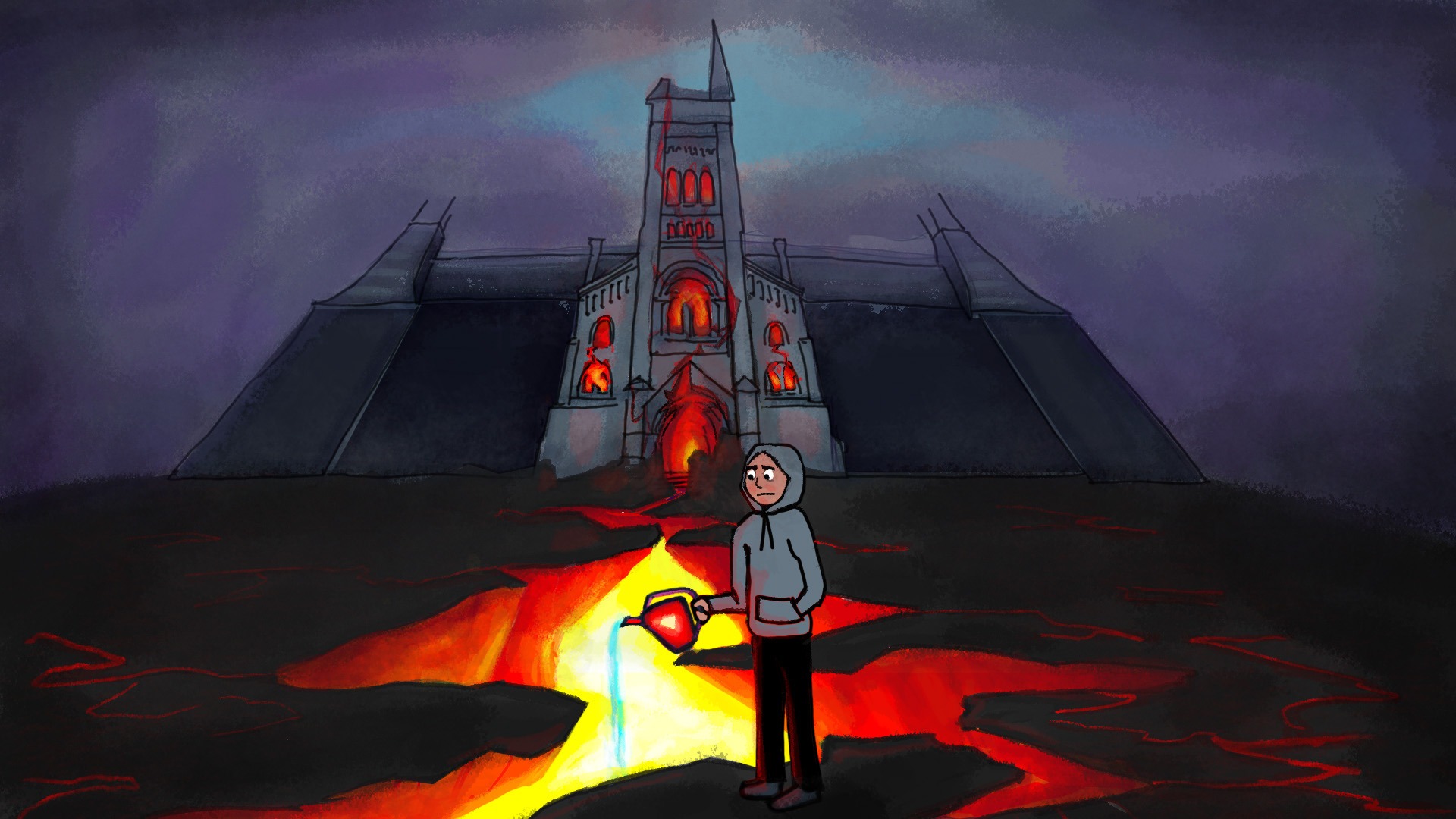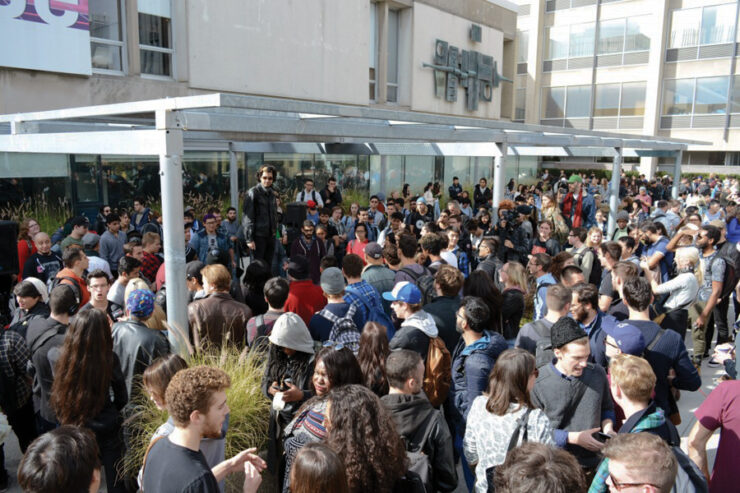Rising tuition fees, donor interference, administrative bloat — welcome to the neoliberalization of higher education
For the 2021-22 academic year, the Fulcrum has revived the Canadian University Press (CUP) Wire to better inform University of Ottawa students on what is making headlines in the Canadian post-secondary world.
The Varsity — Toronto
My feelings toward postsecondary education are quite complicated.
I already loved learning when I was in high school, but university has filled me with a frenzied passion for learning and research that I didn’t know I possessed. I find myself reading anthropology books for leisure, and I’m thrilled every time I learn or unlearn something new. Being in dialogue with creative and radical ideas is intoxicating, and it makes me happy.
But on the other side of this happiness — this excitement of trying to know the world more fully — sits my growing suspicion that postsecondary education is, in many ways, a scam. It’s a system that promises people one thing but does another.
I slowly came to this realization while writing my previous article on the tolls international fees have on students. I started wondering whether high tuition fees truly support what I believe are the primary purposes of public education — to produce knowledge and to educate people for the public good. I wondered if sticking premium price tags on education actually benefits the public.
It took me a lot of time to bring myself to ask these questions. I sincerely used to think that education functions purely as a force for the collective good, unadulterated by the relentless profit-making machinery that dominates the majority of society. I was naive, which is why I ignored all the signs that higher education pointed exactly in the wrong direction.
So I write today from a place of deep concern. As someone who finds fulfillment in learning and who strongly values education, I’m concerned that public higher education has lost its way from its public-serving mission. In five different ways, it has mutated into a self-interested business that produces services designed for a privileged clientele.
I wonder how long this scam will go on for — how long will it take until it snaps and the entire enterprise falls apart? As I see it, scams must eventually arrive at a breaking point, and public higher education is on the edge of this fissure. I’m writing this article because I don’t want education to simply fall apart one day.
1. The tuition boom
Over the past 17 years, the tuition fee of U of T’s Faculty of Arts & Science (FAS) has risen by 46 per cent for domestic students, and by 431 per cent for international students. This isn’t unique — tuition fees in Canada have been outpacing inflation for decades now. Contrary to popular belief, new campus facilities and rising faculty salaries are not the main reasons for this sudden jump. A major reason that tuition fees are skyrocketing is state cutbacks to public education.
To understand why, we need to go back in time. In the 1980s, the Thatcher and Reagan governments in the UK and US applied neoliberal policies that reduced the power of the state, which led to drastic cuts in public services, including publicly funded higher education. Canada followed suit in the 1990s, reducing public spending on higher education by $13 billion in comparison to the prior decade.
Public funding for higher education continues to drop. In 2000, for example, government grants for general operations comprised 26.4 per cent of U of T’s budget. This year, they comprise only 18.1 per cent. Out of all the countries in the Organisation for Economic Co-operation and Development, an intergovernmental organization focused on building better policies, Canada currently allocates one of the lowest amounts of public funds toward higher education.
To try to cope with these cutbacks, public universities have inflated tuition fees for the newly formed class of student consumers. In 2021, U of T, as a “publicly funded” institution, only received $723 million in government grants for general operations, while accruing almost $2 billion from student fees.
As tuition fees increased, public pressure for more financial aid did too. Each year, U of T’s financial aid budget has consistently increased, ballooning to $291 million in 2021 — equivalent to 14 per cent of tuition fee payments.
U of T claims that increasing financial aid is meant to offset rising tuition fees, but all I see is a vicious cycle emerging: the need to raise funds for financial aid spurs further tuition increases, which in turn spurs the need for more financial aid, and so on.
The same cycle is emerging at other universities across Canada. Erika Shaker, a director at the Canadian Centre for Policy Alternatives, told Global News that, in some cases, this cycle is essentially a “student-aid program by students for students.”
Many students find that financial aid is not enough to compensate for the tuition boom — and this is just the tip of the iceberg when it comes to the consequences of withdrawing public funds from public higher education.
2. Knowledge for profit
Sociology professors Claire Polster and Janice Newson have written that public higher education was built on the principles of public collaboration, openness, and free exchange of ideas — principles that are integral to the public interest. But I worry that neoliberalism and market competition have shifted the educational tradition into one that is now more secretive.
In addition to charging high tuition fees, public universities have also commercialized research in order to recuperate state cutbacks. So, instead of making research widely available, some universities have increasingly engaged with intellectual property (IP) practices, which tightly control access to research findings but maximize their revenue in return. In this manner, public universities act more like businesses and less like public-serving institutions.
The academic publishing industry restricts research from the general public in favour of revenue as well. With annual subscriptions to scientific journals generally amounting to around $6,000 and access to one-off articles often costing between $25 to $60, accessing scholarly research without a university affiliation is nearly impossible.
Even with a university affiliation, accessing research can be challenging: universities in lower-income countries may not be able to afford expensive paywalls, which exacerbates information gaps between high-income and low-income countries. This is all happening while peer review is done for free, and scholarly journals like Elsevier raked in $3.2 billion in 2018.
To recuperate from state cutbacks, public universities have also forged close ties with philanthropists and private corporations to get donations, ushering in new cracks for conflicts of interest to emerge. For example, the Canadian Association of University Teachers’ ongoing censure of U of T — currently on pause, but not totally lifted — was caused by alleged donor interference in faculty hiring, while U of T’s recent partnership with pharma giant Novo Nordisk reveals how the products of publicly funded institutions sometimes go to private profiteers.
Public universities are operating increasingly like businesses, while research, information, and knowledge are made less and less accessible to the public. To me, this is far from public service.
3. The supremacy of audits
In the 1990s, a string of scandals rocked trust in the public sector. Barings Bank, which was Great Britain’s oldest investment bank at the time, collapsed; the public’s trust in medical professionals wavered after Dr. Harold Shipman was revealed to have murdered hundreds of his patients; and child sexual abuses within the Catholic church received widespread media coverage.
As it understandably lost its confidence in public institutions, the public demanded increased efficiency, transparency, and accountability from the public sector.
Perhaps, given the neoliberal climate of our time, it comes as no surprise that “accountability” in the context of public universities has also followed principles of neoliberalism and market competition. Ushering in a new era of detailed auditing, quality assurance (QA) measures, and administrative bloats, “accountability” has, thus far, manifested itself as a Byzantine accounting bureaucracy.
It’s now common practice for universities to measure and standardize various facets of education, such as students’ learning experience, faculty performance, and research impact, in terms of quantifiable indicators. This is because manufacturing paper trails is integral to making structures visible for audit.
Aside from increasing the administrative burden on faculty members, researchers find that this system has stifled creativity and innovation, as audits are often assessed based on economic metrics. Measuring accountability in this limited sense overlooks universities’ more complex contributions to society, such as contributions to justice, equality, and environmental sustainability. It also largely renders invisible the crucial peer review, mentoring, and care work that faculty perform — the last of which is disproportionately shouldered by women faculty.
Researchers cannot find evidence that QA measures have actually improved the quality of education by any objective criteria, either. Instead, as anthropologist Jodie-Lee Trembath argued, universities have improved their efficiency — and efficiency and quality are two different things.
Efficiency is no longer merely a means to provide a high quality education. Under audit culture, it has now become an end goal in and of itself — and a futile one at that, as efficiency is an infinite ‘cat and mouse game’ where the next step after efficiency is more efficiency. This is why historical theorist Chris Lorenz wrote that under the neoliberal model, “Efficient, therefore, is never efficient enough.”
Moreover, audits aren’t a reliable means to ensure honesty and proper management. Between 2001 and 2002, large corporations such as Enron and WorldCom were subject to rigorous financial audits by prestigious auditing firms, but they were still able to commit the largest fraud scandals in history.
To be clear, I don’t think that audits are intrinsically harmful or pointless. In fact, I believe they’re important tools for holding institutions accountable. But I’m concerned that the cornerstones of education have been lost to a fetish for quantitative measurement. Faculty instruction is the epicenter of an educational institution, yet universities continue to funnel funds elsewhere.
4. Precarity
The neoliberal model favours cheap, flexible labour — so, like other most jobs, faculty jobs have become more precarious. A study done in 2016–2017 found that more than half of university instructors in Canada are on short-term contracts. Today in Ontario, this number reaches 60 per cent.
It’s easy to see why. Contract faculty are typically paid only a third of the salary that their tenure or tenure-track counterparts make, as their contracts do not include a research component. Still, they are expected to uphold the same standards of instruction.
Labour scholar Adrianna Kezar calls this “the gig academy,” and just like in the gig economy, the gig academy widens racial and gender inequalities as women and racialized minorities are disproportionately represented in contract faculty hires.
Aside from being underpaid, contract faculty are constantly on the edge of unemployment. Because they teach courses on a semester- or year-long basis, some contract faculty describe having to essentially reapply for their jobs every semester or every year. This process becomes a major source of stress and worsened mental health.
Furthermore, university graduates face the same level of instability. Students are entering an increasingly unstable job market, as wages have not kept up with the rising cost of education. Many also enter the workforce burdened with student debt. According to the National Graduates Survey, in 2015, half of all Canadian graduates finished school with a median of $17,500 in loans.
Instability and precarity have become the definitive characteristics of our contemporary era, and we need to look no further than postsecondary education to see that in action.
5. We can’t opt out
Perhaps these problems in higher education won’t be resolved as long as students keep providing large swaths of capital to universities and academics keep accepting contracts. But I think it’s impossible to opt out of participating in these systems without destroying our life prospects. You can’t be an academic without going to a college or university, and your chances of employment significantly decrease without a postsecondary diploma.
As author Jia Tolentino wrote, “I have felt so many times that the choice of this era is to be destroyed or to morally compromise ourselves in order to be functional.” This is exactly how I feel about learning under this corporatized model of education — either I wreck my chances at having a stable livelihood, or I contribute to a wrecked system I don’t agree with.
I enjoy learning and researching. I’ve daydreamed about going to graduate school, conducting fieldwork, and studying issues I care about — but I don’t know how to reconcile my love for learning with the exploitation and corporatization deeply embedded in academia today.
I cannot pretend to be able to anticipate what’s to come. I can only see the small cracks in this scammy system turning into gaping chasms, and I’m not alone in this. At some point while writing this article, I opened Google Search and typed in “scammy synonyms” because I’d wanted to find another word for “scammy.” When the results appeared, I noticed a few entries under the “People also ask” section. The first was, “What is another word for a scammer?” The second entry was far more interesting. It read, “What is another name for diploma?”
Clearly, I am not the only one who sees something seriously broken with our education system.
The Varsity is the University of Toronto’s student newspaper.





